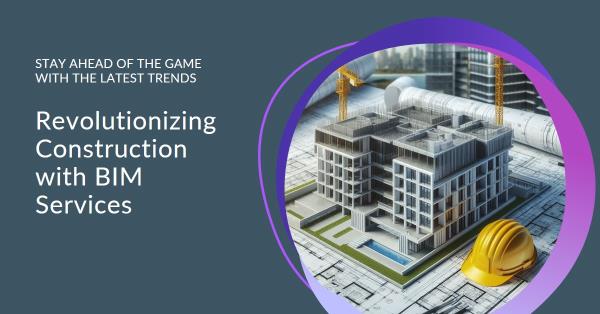
Latest Trends in BIM Services for Construction Efficiency 2024
Building Information Modeling (BIM) has become a transformative force in the construction industry, continuously evolving to meet the growing demands of efficiency, accuracy, and collaboration. As we advance through 2024, several key trends in BIM services are driving significant improvements in construction project management. This article explores these trends, supported by recent statistics and insights, and highlights how solutions from companies like Risentech can enhance construction projects.
1. Integration of Artificial Intelligence and Machine Learning
Artificial Intelligence (AI) and Machine Learning (ML) are making waves in BIM services by automating complex tasks and providing predictive insights. AI algorithms analyze vast amounts of data to forecast potential issues and suggest optimal solutions. Machine learning models can detect patterns from previous projects, improving the accuracy of cost estimations and project scheduling.
Statistics: According to a report by McKinsey & Company, AI in construction is expected to drive a 10-15% reduction in project costs and timeframes by 2025. This trend is gaining traction as AI tools become more sophisticated and accessible.
Example: AI-powered BIM tools can automatically generate clash detection reports, significantly reducing manual review time and minimizing errors.
2. Enhanced Collaboration through Cloud-Based Platforms
Cloud-based BIM platforms are revolutionizing how teams collaborate on construction projects. These platforms provide real-time access to project data, allowing stakeholders to view and update information from anywhere. This enhances communication, reduces misunderstandings, and accelerates decision-making processes.
Statistics: Deloitte reports that 73% of construction companies have adopted cloud-based solutions for BIM, citing improved project coordination and reduced administrative overhead.
Example: A cloud-based BIM system enables project managers, architects, and engineers to work simultaneously on the same model, ensuring that all team members have the most up-to-date information.
3. Integration of Internet of Things (IoT) Devices
IoT technology is becoming increasingly integrated with BIM services, providing real-time data on construction sites. IoT devices such as sensors and wearables collect data on various parameters like temperature, humidity, and equipment performance. This data is then fed into BIM models to monitor progress and ensure compliance with safety and quality standards.
Statistics: The Gartner report predicts that by 2024, 40% of construction projects will use IoT data to enhance BIM models, leading to improved operational efficiency and safety.
Example: Sensors embedded in building materials can track their condition and performance, alerting project managers to potential issues before they escalate.
4. Adoption of 4D and 5D BIM
While traditional BIM focuses on 3D modeling, the adoption of 4D and 5D BIM is gaining momentum. 4D BIM integrates time-related information, allowing project managers to visualize the construction process over time. 5D BIM adds cost data, providing a comprehensive view of project budgets and financial implications.
Statistics: BuildingSmart International notes that 4D and 5D BIM can reduce project delays by up to 20% and cost overruns by 15%, respectively.
Example: A 4D BIM model can simulate the construction sequence, helping teams identify potential scheduling conflicts and optimize workflows.
5. Focus on Sustainable Construction
Sustainability is a growing concern in the construction industry, and BIM services are aligning with this trend by incorporating green building practices. BIM tools now include features for energy modeling, material efficiency, and waste management, helping projects meet sustainability goals and regulations.
Statistics: ResearchGate highlights that the use of BIM for sustainable design can lead to a 25% reduction in energy consumption and a 30% decrease in construction waste.
Example: BIM software can simulate energy performance and suggest modifications to improve the building’s environmental impact, supporting compliance with green building certifications.
How Risentech Can Help
At Risentech, we are at the forefront of these BIM trends, offering cutting-edge BIM solutions that enhance construction project management. Our expertise in BIM solutions and real estate development ensures that projects benefit from the latest technologies and practices, driving efficiency and success.
FAQs
1. What is the difference between 3D, 4D, and 5D BIM?
3D BIM focuses on geometric modeling, 4D BIM integrates time-related information, and 5D BIM adds cost data, providing a comprehensive view of project schedules and budgets.
2. How can AI improve BIM services?
AI can automate tasks like clash detection and provide predictive insights, reducing manual effort and enhancing accuracy in project management.
3. What are the benefits of using cloud-based BIM platforms?
Cloud-based platforms offer real-time data access, improved collaboration, and reduced administrative overhead, streamlining project coordination.
4. How does IoT technology integrate with BIM?
IoT devices collect real-time data on construction sites, which is then integrated into BIM models to monitor progress and ensure compliance with safety and quality standards.
5. What role does BIM play in sustainable construction?
BIM tools support sustainable practices by modeling energy performance, material efficiency, and waste management, helping projects meet environmental goals.
Conclusion
The latest trends in BIM services are driving unprecedented efficiency in construction project management. From AI and cloud-based collaboration to IoT integration and sustainability, these advancements are transforming how projects are planned and executed. Risentech is well-positioned to support construction projects with advanced BIM solutions, ensuring that they leverage these innovations effectively. As the construction industry continues to evolve, how will your organization adapt to these emerging BIM trends?
Also know Leveraging Architectural Services for Construction Efficiency





Leave Your Comment